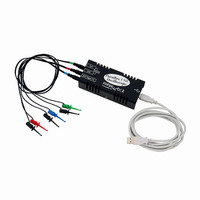28014 Parallax Inc, 28014 Datasheet - Page 54

28014
Manufacturer Part Number
28014
Description
OSCILLOSCOPE USB 200KHZ
Manufacturer
Parallax Inc
Type
USBr
Specifications of 28014
Includes
Probes, Software, USB Cable
Bandwidth
200kHz
Channels
Dual
Display Type
None - Requires Computer and Monitor
Probe Type
Hook Probes x1 (3)
Sampling Rate (per Second)
500ks/s
Voltage - Input, Max
20V p-p
Voltage - Supply
5 VDC, USB Powered
Product
Microcontroller Accessories
Lead Free Status / RoHS Status
Lead free / RoHS Compliant
Features
-
Input Impedance
-
Rise Time (typ)
-
Lead Free Status / Rohs Status
Lead free / RoHS Compliant
Other names
Q2119020
Your two measurements should be very near 2 kHz and 6 kHz.
Summary
Even though the OPTAscope is a digital oscilloscope, it is well suited to view both digital
and analog signals. Digital signals are usually either high or low, whereas analog signals
can be high, low, or at any voltage in between. Sound waves are made up of sine waves.
√
√
√
√
√
√
√
√
Set the Horizontal dial to 1 ms. You should see a compressed view of the mixed
signal.
Press the FFT button, and the FFT Window will open (Figure 3-11).
Select Black - Harris in the Windowing box.
Click on the ON/OFF button in the Cursor box to turn on the FFT cursor.
Locate the FFT cursor, a white vertical line with a square handle all the way to
the left in the FFT Plot Area.
Move the cursor to the first peak to the right.
Read the Frequency measurement in the Cursor box.
Repeat to measure the second peak.
Figure 3-11:
The OPTAscope
FFT Window.
Note that the FFT
cursor measures
near 2 kHz at the
first peak.










